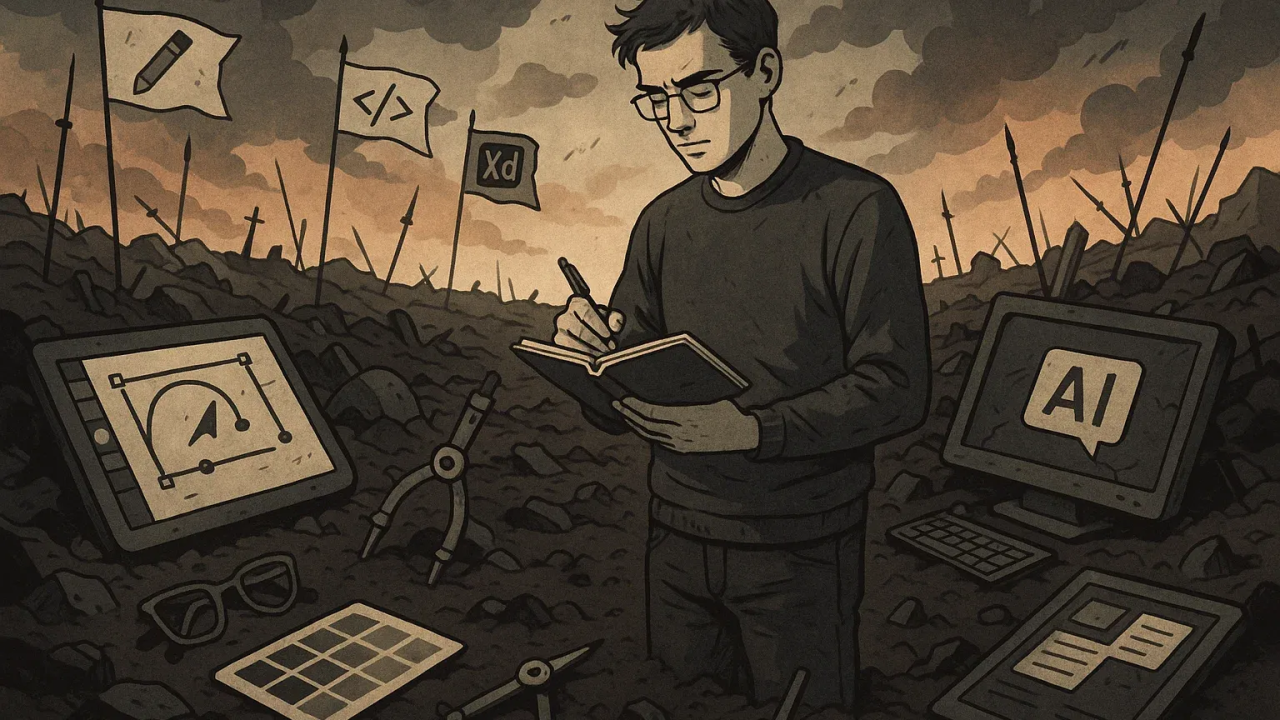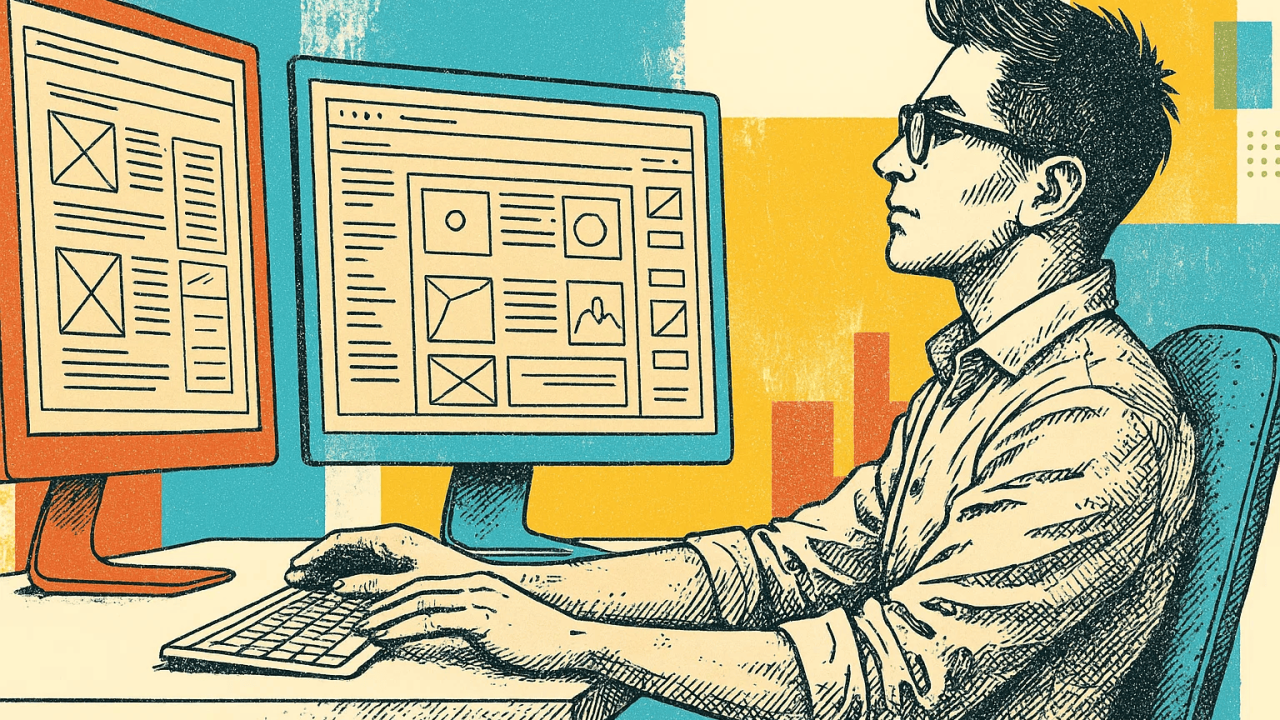Welcome back! 👋
Previously, we explored how colour and contrast can help us shape visual hierarchy.
Today, we’ll talk about something equally important but, sadly, often misunderstood: whitespace.
What’s Inside:
- Whitespace in Modern Design
- How It Affects Visual Hierarchy
- Takeaways
When you think about it, often a part of a design that has the most impact is the one most overlooked—the subtle element that doesn’t draw attention to itself but quietly amplifies everything around it instead.
That’s exactly the power of whitespace.
Whitespace (or negative space) is one key factor in creating structure, improving readability, and guiding users through a design.
And yes, it’s true—it hasn’t always been a priority in web design.
Back in the 90s, websites were packed with as much content as possible, cramming everything into limited screen space to grab attention or push users to click before they even scroll.
But we’re not in the 90s anymore and, thankfully, we’ve moved on.
We’ve learned that whitespace isn’t wasted space but it’s a vital part of good design.
And let’s not buy into the idea that “people don’t scroll” and that everything must be crammed above the fold to get quick action from users.
Because let’s be honest—that mindset doesn’t really hold up.
Think about it: what’s worse: Users leaving because they didn’t want to scroll, or leaving because the site is so cluttered it’s unusable?
Whitespace gives your content room to breathe, making it easier to read, navigate, and engage with.
Isn’t that what we’re all aiming for?
So let’s put the misconceptions aside and focus on using whitespace effectively.
A great design grabs attention (even before users scroll) and encourages them to explore further.
Whitespace plays a key role in making this happen.
So today, let’s talk about:
- Why is whitespace necessary?
- What does it help us accomplish?
- What does it add or take away?
- And how can we use it to achieve the results we’re after?
Let’s dive in! →
“Negative space is one of the most powerful design tools that any designer can use” – Interaction Design Foundation
Every element in a design is important, but just as crucial as the elements you place (or deliberately leave out) on the page, is the space around them.
Whitespace is integral to the design itself.
It helps create balance, ease of use, and even shapes how users feel when they interact with your product.
Ultimately, we want users to process information as quickly and easily as possible, helping them make decisions faster and more effectively.
Whitespace is essential for this, as it highlights focal points and guides the flow of a design.
✨Here’s how it shapes visual hierarchy:
1️⃣ It Guides the Eye
Unlike reading a book, we don’t read websites and apps in a linear way.
Our eyes are constantly moving, scanning for the next piece of information.
And let’s not forget that users spend only 10–20 seconds scanning a page before deciding whether to stay or leave. (NNG)
If they can’t quickly focus on what matters, they’re more likely to leave.
When you control how much space surrounds different elements, you naturally lead the user from one part of the page to the next, ensuring that they stay longer.
👉What to do:
Use whitespace as a guide for your users.
Make sure key elements stand out by giving them plenty of space. Keep secondary content tighter, but still readable.
2️⃣ It Boosts Legibility
Anyone who’s ever stared at a dense block of text knows how exhausting it can be.
At the micro level, whitespace can help improve the legibility of the content.
Adding just a bit of space between lines, paragraphs, and sections (leading, kerning and tracking) makes the content flow better.
Rather than making things look pretty, it’s about making sure the content is usable and accessible.
Additionally, Nielsen Norman Group’s studies show that increasing line spacing improves both reading speed and comprehension. [3]
More space means users don’t have to work as hard to process the information, so they can focus and stay engaged longer.
👉What to do:
Increase line spacing, set proper margins, and add padding around text blocks.
This will help break up your content into smaller, easier-to-read pieces.
3️⃣ It Reduces Cognitive Load
Cluttered interfaces overloaded with visuals and distractions pull users away from their goals. Working memory […] becomes overwhelmed by competing stimuli. This leads to information overload and hinders the ability to focus on the task at hand. [4]
Cluttered designs require more mental energy to process.
That mental energy is referred to as cognitive load.
When a design is cluttered, users have to work harder to make sense of it, requiring more mental effort to process information.
Whitespace helps reduce that effort by providing enough breathing room around key elements. With less to process, users can focus better on what matters.
👉What to do:
Remove unnecessary elements. Keep only what’s essential and use whitespace to create separation between sections to make the design feel lighter and easier to understand.
4️⃣ It Helps Elements Stand Out
When using whitespace to separate key elements, you make them more visible and easier to identify. This creates clear focal points, which human eyes are naturally drawn to.
For example, if you surround a call-to-action button with enough space, it immediately grabs attention, making it obvious where users should click.
Without whitespace, even the most important elements can get lost in the clutter.
👉What to do:
Ensure that key elements have enough space around them.
This will help users spot them quickly and take the intended action without hesitation.
5️⃣ It Sets The Tone
A clean, well-spaced design feels calm and inviting.
It helps set a tone for your design and helps tell a story about who you are, and what you stand for.
Whitespace can enhance or change the elements it touches or follows, and even tell a story all on its own. [5]
The more whitespace there is, the more elegant and sophisticated your design can feel.
It creates a sense of luxury and openness, giving users the impression that the design is well-thought-out and of high quality.
This signals to users that you value their time and understand their needs.
👉What to do:
Think about the emotional tone your design sets.
Use whitespace to create a sense of calm, clarity, and even luxury, if that’s what you’re after. Aim to create a positive and easy-to-navigate experience.
6️⃣ It Encourages Interaction
Too little whitespace around interactive elements could lead to higher error rates.
On the flip side, when interactive elements are given enough room, users are much less likely to misclick or become frustrated trying to perform actions.
Whitespace makes interactions easier.
It helps users feel confident and in control, which is essential for smooth interactions.
👉What to do:
Make sure your interactive elements are well-spaced. This helps users interact with them more easily and reduces the likelihood of errors.
✨Takeaways:
1️⃣ Give key elements space to stand out, while keeping secondary content tighter but still easy to read.
2️⃣ Use whitespace on a micro level—increase line spacing, tweak margins, and add padding around text to make content easier to read.
3️⃣Use whitespace to separate sections, making the design easier to navigate.
4️⃣Make sure key elements (CTA’s, links, forms nav items etc) have enough space around them so users can find them more easily.
5️⃣Use whitespace to set the desired tone of your design.
6️⃣Make sure interactive elements are spaced out. It helps users interact smoothly and reduces mistakes.
The shift from the crowded, content-heavy designs of the past shows how much we’ve evolved as a design community.
Moving away from the cluttered, information-packed designs we’ve learned that simplicity often leads to better user engagement.
Whitespace is now recognised as a key element in guiding users and allowing them to focus on what matters most.
It guides their attention, makes content more digestible, and creates a sense of balance.
When we allow space to shape our designs, we do more than just clear visual clutter—we build trust and clarity, exhibiting our understanding of what users need.
Whitespace improves user experience and usability by organising elements, creating clear connections, or separating them when necessary.
It ensures everything has its place within a design.
And that often equals to a product that is easy to use and a pleasure to look at.
Thoughts? 💭
Comment below and let’s chat! 😉
See you next week 👋
This space thrives because of YOU. ❤️
If the resources I share help you grow in your career, a small contribution from you could keep this community strong.
Together, we’re building a space to learn, grow, and support each other on this design journey.
Every bit helps, and by supporting me, you’re directly helping keep this space alive and growing.
Or simply scan this QR code ⬇️

Your support means a lot!
You might also like:
Sources:
- Negative Space by Interaction Design Foundation
- How Long Do Users Stay on Web Pages? by Nielsen Norman Group
- Legibility, Readability, and Comprehension: Making Users Read Your Words by Nielsen Norman Group
- Understanding Cognitive Load in UX and How to Minimize it? by Design Studio UI UX
- What is whitespace and how to use it in design by Webflow
Share this article:





Great information shared.. really enjoyed reading this post thank you author for sharing this post .. appreciated
Thank you for being such a clear, reasoned voice in what can often be a chaotic online environment. Your ability to present balanced arguments, even on potentially contentious topics, is truly appreciated and fosters meaningful discussion.
Pretty! This has been a really wonderful post. Many thanks for providing these details.